Growing Your Own Cut Flower Garden

Imagine walking through aisles of flowers right outside your door, selecting what you want, making a bouquet, and not paying — sound good? If it does, then perhaps you should consider growing your own cut-flower garden. Even if you have a garden already, chances are good that you worry about cutting too many flowers and detracting from the beauty of your garden; with a cut garden, you no longer have to worry about this. I like cut gardens because they offer the chance to grow hard-to-find plants and experiment with plants you may want to put in your feature gardens. By now, I am sure you are sold on the idea, so here are some tips on how to start a cut-flower garden. Location The great thing about cut gardens is that they do not have to look good; cut gardens are there for function, not beauty. They are best tucked away in an area of your property that is not the focal point. Most likely, the garden should be located in an area that receives full sun, since most flowers require it. It should also have rich, well-drained soil just like your other gardens. Many people who have cut-flower gardens combine them with their vegetable gardens, which has the benefit of dressing up the vegetable garden and, depending on the flower, could also offer the vegetables some protection from pests.
Design If you have decided to create a garden just for cut flowers, you will want to design it the way you would design a vegetable garden. Plant flowers in rows with plenty of space in between the rows for you to walk, weed, and cut. Covering the beds with mulch or landscaping fabric will greatly reduce weeds and watering. I love raised beds, and if you want to make them neater in appearance, you can outline them with wood, brick, or stone. The size of the garden will vary depending on how much space you have, your budget, and how many flowers you plan on using. As a guide, a three-by-six-foot garden generally holds about 20 plants. My advice is to start small, since you can always expand later if you want to. Choosing Flowers I think this is the hardest part! First of all, realize that you will need a combination of large flowers that will be the focal points of your bouquets and smaller filler flowers — and don’t forget plants with interesting foliage. Second, choose plants that do well in your area by determining what hardiness zone you live in, and then, when shopping for plants, check the tag or plant information to make sure that the plant is suited for your zone. Third, plant lots of annuals as well as long-blooming perennials — this will ensure you a constant supply of flowers. Annuals thrive on cutting, producing more flowers the more you pick or cut. If you have a favorite perennial, even if it has a short bloom time, you may want to include it. Roses and bulb plants like tulips and lilies are gorgeous, but realize that other flowers will grow more quickly with less care. Planting In general, flowers should be planted after the danger of frost has passed; however, there are some flowers and foliage, such as pansies and ornamental kale, that can stand frost. To be sure, do a little research on the plant you are interested in and find out when to plant it. I recommend planting as soon as you possibly can so that you can start cutting as soon as possible. If you are planting a large garden, it may be financially wise to start flowers from seed. This is also a good way to grow rare varieties that can’t be found in stores. If you are starting flowers from seed, you will need to start weeks before the plants can be planted; the seed package will tell you when to start seeds.
Harvesting In general, you should harvest flowers during the coolest time of day, such as early morning or late evening. Make sure to cut stems long because you will be cutting them again. Strip leaves off of the bottoms of stems that will be underwater. Put the cut flowers in a bucket of room-temperature water, and then cut the stems again underwater — this prevents air bubbles from obstructing the stems. You may want to use a floral preservative. Also, if possible, design your bouquet while the flowers are in water. Some flowers have special needs, such as short-lived ones like daylilies, hibiscus, and irises. For these, cut them at the bud stage; they will open in the vase. Some Ideas Some good annual to plant for cutting are Bells of Ireland, zinnias, cosmos, sunflowers, statice, and snapdragons. Black-eyed Susans, daisies, delphinium, baby’s breath, coneflowers, and coral bells are just a few perennials that serve as excellent cut flowers. Good foliage plants are coleus, lamb’s ear, dusty miller, and lavender. Plant groups of perennials that bloom at the same time so that you can combine them in a bouquet. Most annuals will bloom all summer, so any of them can be added to these perennials. Here are some bouquet ideas that contain a mix of annuals, perennials, focal flowers, and filler flowers that bloom at the same time:
- Summer bouquet: Sunflowers, speedwell, yarrow, ageratum, liatris, hydrangea, snapdragons
- Spring bouquet: Peonies, iris, speedwell, annual baby’s breath, poppies, forget-me-nots
- Fall bouquet: Chrysanthemums, asters, coreopsis, dahlia, goldenrod, sedum, ornamental kale
More information about the author:



